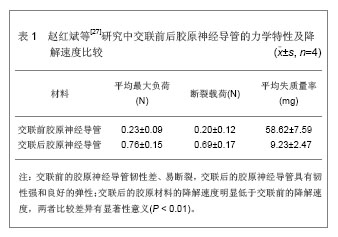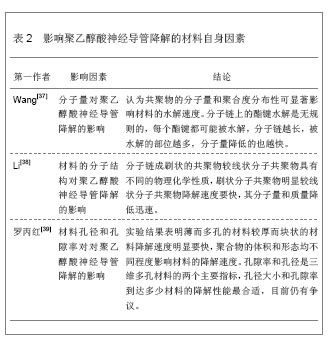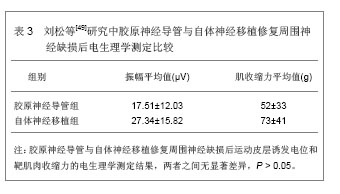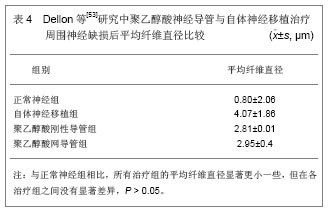| [1]张勇杰,金岩,聂鑫,等.组织工程周围神经修复坐骨周围神经缺损应用研究[J].中华神经外科疾病研究杂志,2004,3(2):141-144.[2]游华,矫树生,陈建梅,等.组织工程人工神经对大鼠坐骨周围神经缺损后神经再生速度的影响[J].成都医学院学报,2010,5(3): 193-195.[3]游华,矫树生,冯帅南,等.OEC-SC-ECM-PLGA桥接体对大鼠坐骨周围神经缺损的解剖学修复作用[J].第三军医大学学报,2008, 30(21):2015-2019.[4]吴志伟,陈峥嵘,汪洋,等.人胚雪旺细胞组织工程神修复坐骨周围神经缺损的实验研究[J].中国临床医学,2006,13(5):810-813.[5]Barcelos AS,Rodrigues AC,Silva MD,et al.Inside-out vein graft and inside-out artery graft in rat sciatic nerve repair. Microsurgery.2003;23(1):66-71.[6]Mohammad JA,Warnke PH,Pan YC,et al.Increased axonal regeneration through a biodegradable amnionic tube nerve conduit: effect of local delivery and incorporation of nerve growth factor/hyaluronic acid media.Ann Plast Surg.2000; 44(1):59-64.[7]Bini TB,Gao S,Xu X,et al.Peripheral nerve regeneration by microbraided poly(L-lactide-co-glycolide) biodegradable polymer fibers.J Biomed Mater Res A.2004;68(2):286-295.[8]Weiss p,The technology of nerve regeneration:sutureless tubulation and related methods of repair.Neurosury.1944; 1:400.[9]蒋良福,劳杰,何继银,等.几丁糖胶原复合膜及激活态雪旺细胞修复周围神经缺损的实验研究[J].中华手外科杂志,2005,21(3): 172-174.[10]刘俊建,王建广,魏延云,等.同轴共纺复合神经生长因子导管修复大鼠坐骨周围神经缺损的实验研究[J].中华创伤骨科杂志,2009, 11(4):351-356.[11]董红让,徐达传,徐永年,等.外消旋聚乳酸复合神经生长因子缓释导管促周围神经再生的形态学研究[J].中国修复重建外科杂志, 2006,20(8):787-790.[12]中国知网.中国学术期刊总库[DB/OL].2012-08-10. https://www.cnki.net[13]SCI数据库.Web of Sciencevia ISI Web of Knowledge[DB/OL]. 2012-08-10.http://ip-science.thomsonreuters.com/mjl[14]Mohammad J,Shenaq J,Rabinovsky E,et al.Modulation of peripheral nerve regeneration: a tissue-engineering approach. The role of amnion tube nerve conduit across a 1-centimeter nerve gap.Plast Reconstr Surg.2000;105(2): 660-666.[15]洪光祥,陈振兵.周围神经端侧吻合的研究进展[J].实用手外科杂志,2006,20(2):67-69.[16]Wang X,Hu W,Cao Y,et al.Dog sciatic nerve regeneration across a 30-mm defect bridged by a chitosan/PGA artificial nerve graft.Brain.2005;128(8):1897-1910.[17]戴传昌,商庆新,王炜.用组织工程方法桥接周围神经缺损的实验研究[J].中华外科杂志,2000,13(5):388.[18]冯世庆,李崴,陈家,等.壳聚糖-胶原生物膜介导雪旺细胞联合神经干细胞桥接周围神经缺损[J].中华实验外科杂志,2008, 25(12): 1630-1632.[19]Stang F,Fansa H,Wolf G,et al.Structural parameters of collagen nerve grafts influence peripheral nerve regeneration.Biomaterials.2005;26(16):3083-3091.[20]卢凤琦,庄昭霞,曹晶,等.可降解性壳聚糖复合膜的研制与生物学评价[J].生物医学工程学杂,2003,20(2):277-280.[21]刘新,郑启新,吴永超,等.三种人工可降解材料上雪旺细胞培养的体外活性研究[J].医药论坛杂志,2008,29(14):4-8.[22]崔树森,徐莘香,尹维田,等.组织工程人工周围神经的研制[J].白求恩医科大学学报,2000,26(1):20-22.[23]医师网.组织工程:神经修复的一把利器[DB/OL].2010-8-23. http://www.mdweekly.com.cn/article.asp?id=27781[24]Tos P,Battiston B,Geuna S,et al.Tissue specificity in rat peripheral nerve regeneration through combined skeletal muscle and vein conduit grafts.Microsurgery.2000; 20(2): 65-71.[25]Dezawa M,Takahashi I,Esaki M,et al.Sciatic nerve regeneration in rats induced by transplantation of in vitro differentiated bone-marrow stromal cells.Eur J Neurosci. 2001;14(11):1771-1776.[26]Cuevas P,Carceller F,Dujovny M,et al.Peripheral nerve regeneration by bone marrow stromal cells.Neurol Res. 2002;24(7):634-638.[27]赵红斌,马敬,杨银书,等.胶原神经导管对外周周围神经缺损修复的实验研究[J].生物医学工程与临床,2010,14(2):100-104.[28]Maquet V,Martin D,Malgrange B,et al.Peripheral nerve regeneration using bioresorbable macroporous polylactide scaffolds.J Biomed Mater Res.2000;52(4):639-651.[29]Hadlock T,Elisseeff J,Langer R,et al.A tissue-engineered conduit for peripheral nerve repair.Arch Otolaryngol Head Neck Surg.1998;124(10):1081-1086.[30]Federoff HJ,Geschwind MD,Geller AI,et al.Expression of nerve growth factor in vivo from a defective herpes simplex virus 1 vector prevents effects of axotomy on sympathetic ganglia.Proc Natl Acad Sci U S A.1992;89(5):1636-1640.[31]Baumgartner BJ,Shine HD.Targeted transduction of CNS neurons with adenoviral vectors carrying neurotrophic factor genes confers neuroprotection that exceeds the transduced population.J Neurosci.1997;17(17):6504-6511.[32]Meek MF,Van Der Werff JF,Nicolai JP,et al.Biodegradable p(DLLA-epsilon-CL) nerve guides versus autologous nerve grafts: electromyographic and video analysis.Muscle Nerve. 2001;24(6):753-759.[33]Zhang Y,Dijkhuizen PA,Anderson PN,et al.NT-3 delivered by an adenoviral vector induces injured dorsal root axons to regenerate into the spinal cord of adult rats.J Neurosci Res.1998;54(4):554-562.[34]Baumgartner BJ,Shine HD.Permanent rescue of lesioned neonatal motoneurons and enhanced axonal regeneration by adenovirus-mediated expression of glial cell-line-derived neurotrophic factor.J Neurosci Res.1998;54(6):766-777.[35]Giménez y Ribotta M,Revah F,Pradier L,et al.Prevention of motoneuron death by adenovirus-mediated neurotrophic factors.J Neurosci Res.1997;48(3):281-285.[36]沈华,沈尊理,张佩华,等.甲壳素涂层并预置引导纤维神经导管的实验研究[J].中国修复重建外科杂志,2005,19(11):860-863.[37]Nuo Wang,Xue Shen Wu,et al.A novel approach to stabilization of protein drugs in poly(lactic-co-glycolic acid)microspheres using agarose hydrogel.International Journal of Pharmaceutics.1998;1(166):1-14.[38]Youxin Li,Christian Volland,Thomas Kissel.Biodegradable brush-like graft polymers from poly(D,L-lactide)or poly(D,L-lactide-coglycolide)and controlled releases of hydrophilic macromolecules.Polymer.1998;14(39):3087-3097.[39]罗丙红,全大萍,廖凯荣,等.低热-高压法制备PLGA多孔支架及其体外降解研究[J].功能高分子学报,2003,19(2):149-154.[40]Fakoya FA,Caxton-Martins EA.Neocortical neurodegeneration in young adult Wistar rats prenatally exposed to ethanol.Neurotoxicol Teratol.2006;28(2):229-237.[41]Tabakoff B,Hoffman PL.Animal models in alcohol research.Alcohol Res Health.2000;24(2):77-84.[42]Raimondo S,Nicolino S,Tos P,et al.Schwann cell behavior after nerve repair by means of tissue-engineered muscle-vein combined guides.J Comp Neurol.2005;489(2):249-259.[43]Origlia N,Capsoni S,Domenici L,et al.Time window in cholinomimetic ability to rescue long-term potentiation in neurodegenerating anti-nerve growth factor mice.Alzheimers Dis.2006;9(1):59-68.[44]顾玉东.周围神经缺损的基本概念与治疗原则[J].中华手外科杂志,2002,18(3):129-130.[45]Rosales-Cortés M,Peregrina-Sandoval J,Bañuelos-Pineda J,et al.Immunological study of a chitosan prosthesis in the sciatic nerve regeneration of the axotomized dog.J Biomater Appl.2003;18(1):15-23.[46]Williams LR.Rat aorta isografts possess nerve regeneration-promoting properties in silicone Y chambers. Exp Neurol.1987;97(3):555-563.[47]张毅,李小林,钟映春,等.基于二次成像技术标志点获取和自动配准的长段周围神经功能束三维可视化关键技术研究[J].中国修复重建外科杂志,2010,24[48]Hadlock T,Sundback C,Hunter D,et al.A polymer foam conduit seeded with Schwann cells promotes guided peripheral nerve regeneration.Tissue Eng.2000;6(2):119-127.[49]刘松,刘宗惠,G.Said.通过胶原管架桥使轴突从脊髓到神经根再生长的研究[J].中华神经外科杂志,2000,16(5):324.[50]Huang J,Xiang J,Yan Q,et al.Dog tibial nerve regeneration across a 30-mm defect bridged by a PRGD/PDLLA/β-TCP/NGF sustained-release conduit.Reconstr Microsurg.2013;29(2):77-87.[51]Xu H,Yan Y,Wan T,et al.Degradation properties of the electrostatic assembly PDLLA/CS/CHS nerve conduit.Biomed Mater.2009;4(4):45-60.[52]Dong H,Xu D,Xu Y.Morphologic research on PDLLA/NGF-controlled release conduit promoting peripheral nerve regeneratio.Zhongguo Xiu Fu Chong Jian Wai Ke Za Zhi.2006;20(8):787-790.[53]医药卫生.传统神经移植治疗短周围神经缺损的替代疗法[DB/OL].2012-11-15.http://www.doc88.com/p-338768269608.html |



